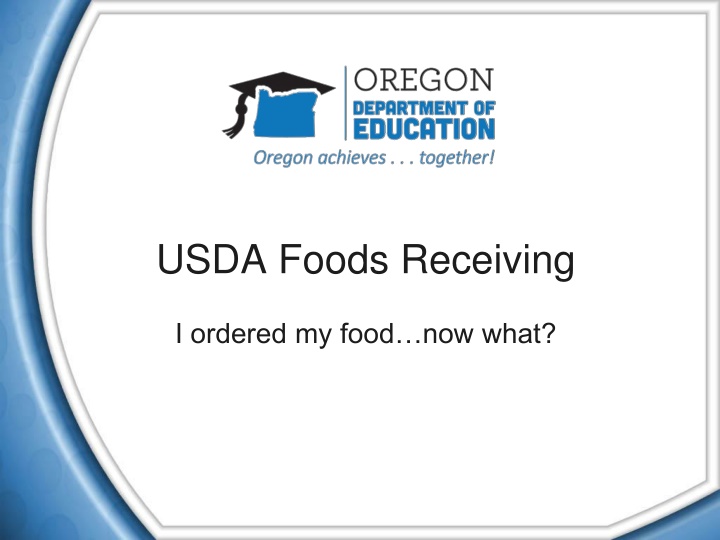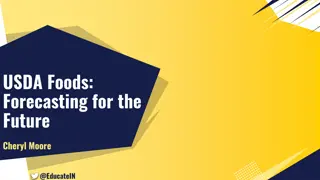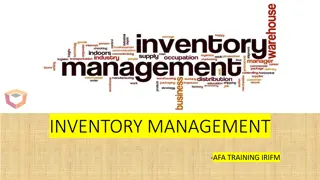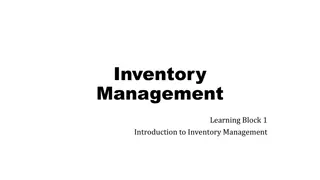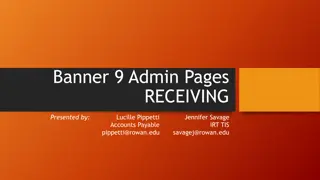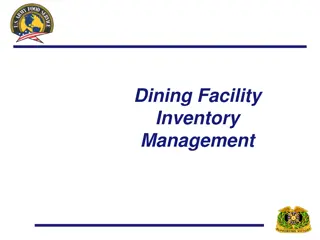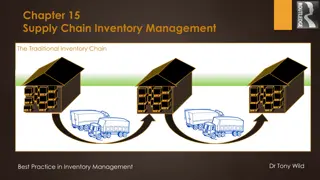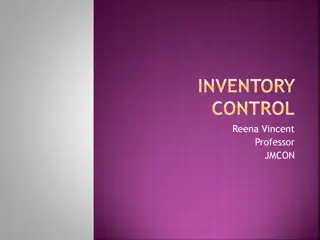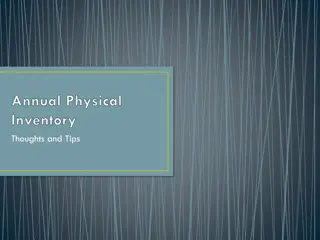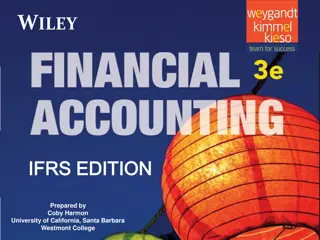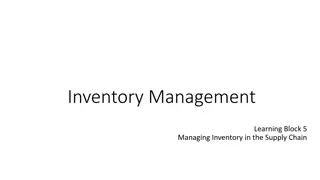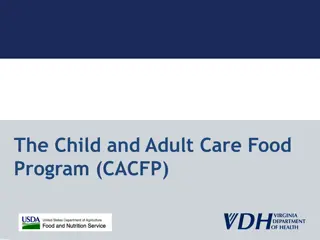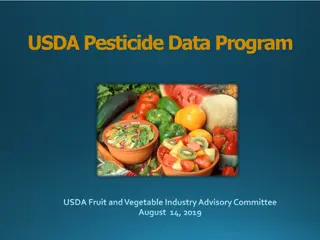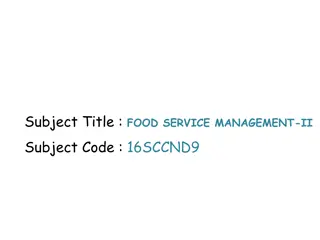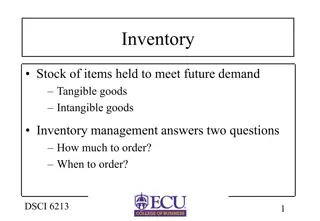Managing USDA Food Receiving and Inventory Basics
Learn about the processes involved in receiving USDA foods, managing inventory using FIFO, understanding storage conditions, determining expiration dates, and interpreting best-if-used-by dates. Ensure proper handling and storage to maintain food quality and safety.
Download Presentation

Please find below an Image/Link to download the presentation.
The content on the website is provided AS IS for your information and personal use only. It may not be sold, licensed, or shared on other websites without obtaining consent from the author.If you encounter any issues during the download, it is possible that the publisher has removed the file from their server.
You are allowed to download the files provided on this website for personal or commercial use, subject to the condition that they are used lawfully. All files are the property of their respective owners.
The content on the website is provided AS IS for your information and personal use only. It may not be sold, licensed, or shared on other websites without obtaining consent from the author.
E N D
Presentation Transcript
USDA Foods Receiving I ordered my food now what?
Different processes for each USDA Foods Program Direct delivery Release inventory from Good Source/TFS E- commerce System Sponsor receives and validates quantities and condition Good Source/TFS confirms delivery date Food arrives on truck Processing Receives food from processor via direct ship, distributor or TFS/Good Source Sponsor receives and validates quantities and condition Sponsor checks value pass through method used and verifies credit. Place order with processor
Processes for receiving continued USDA DoD Fresh Fruit & Vegetable Program Sponsor receives and validates quantities and condition Duck Delivery confirms delivery date Sponsor validates order received in FFAVORS Place order in DoD FFAVORS System Food arrives on truck Unprocessed Fruit and Vegetable Pilot Sponsor receives and validates quantities and condition Sponsor signs invoice that vendor submits to USDA for payment Place order with approved vendor Vendor confirms delivery date Food arrives on truck
Inventory Basics for all Foods received First-in-first-out (FIFO) The most basic rule of inventory management is FIFO. This means using the oldest product first and tracking it.
Inventory Basics for all Foods received Storage conditions Significant impact. The same product will last for different periods of time depending on the temperature of the storeroom, the humidity level, and air circulation. Cool temperatures and low humidity provide the best storage conditions. Store food off the floor and away from contact with walls and ceilings.
Expiration Dates How can I tell when a product has gone out of condition? Is there a single date I can refer to? Not Really! Use your best judgement. When in doubt, toss!
Best-if-used-by Date A best-if-used-by date means that the manufacturer recommends using the product by this date. At some point after that date, product will change very gradually in taste, color, texture, or nutrient content. The product may still be wholesome and safe.
Sell-by Date A sell-by date on a food product means the manufacturer recommends that a store sell the product by that date. It is assumed that the product may then be stored for some period of time before it is used. These various dating systems do not represent expiration dates, and do not indicate when product safety becomes an issue.
Sell-by Date Safety If there are no visible signs of spoilage, but you have reason to question the product. Conduct sensory evaluation: Observe condition of the food including color, texture, and smell. If the food displays acceptable color, texture, and smell, use best judgment regarding the quality of the food and whether or not to serve it. DO NOT taste any food that you have reasonable basis to suspect is unwholesome or unsafe.
How can I tell if a product is safe? If you have reason to question the wholesomeness or safety of a food product, open a case or individual package examine the cans or packages for rust, bulging, broken seals, insect infestation or other visible defects. If any of these conditions are present, the food is generally considered NOT fit for human consumption.
Value of Commodities Received Official Record of Entitlement Direct Delivery and Diversion WBSCM Business Manager access DoD Fresh FFAVORS Unprocessed Fruit and Vegetable Pilot AMS report
Service Fee Billing Based on Value of Commodities Received Report WBSCM Billing Timeline Direct Delivery/Diversion - after received to state/processor warehouse DoD Billed twice yearly Unprocessed Pilot Billed once yearly Invoice Detail Report CNPweb - SNP
Non-Discrimination Statement In accordance with Federal civil rights law and U.S. Department of Agriculture (USDA) civil rights regulations and policies, the USDA, its Agencies, offices, and employees, and institutions participating in or administering USDA programs are prohibited from discriminating based on race, color, national origin, sex, disability, age, or reprisal or retaliation for prior civil rights activity in any program or activity conducted or funded by USDA. Persons with disabilities who require alternative means of communication for program information (e.g. Braille, large print, audiotape, American Sign Language, etc.), should contact the Agency (State or local) where they applied for benefits. Individuals who are deaf, hard of hearing or have speech disabilities may contact USDA through the Federal Relay Service at (800) 877-8339. Additionally, program information may be made available in languages other than English. To file a program complaint of discrimination, complete the USDA Program Discrimination Complaint Form, (AD-3027) found online at: http://www.ascr.usda.gov/complaint_filing_cust.html, and at any USDA office, or write a letter addressed to USDA and provide in the letter all of the information requested in the form. To request a copy of the complaint form, call (866) 632-9992. http://www.ascr.usda.gov/complaint_filing_cust.html Submit your completed form or letter to USDA by: (1) mail: U.S. Department of Agriculture Office of the Assistant Secretary for Civil Rights 1400 Independence Avenue, SW Washington, D.C. 20250-9410; (2) fax: (202) 690-7442; or (3) email: program.intake@usda.gov program.intake@usda.gov This institution is an equal opportunity provider.
